Assembling Typical Meteorological Year Data Sets for Building Energy Performance Using Reanalysis and Satellite-Based Data
Abstract
:1. Introduction
- In Italy, the climatic data collection “Gianni De Giorgio” (IGDG) (a set of 66 climatic data sets is based on a 1951–1970 period of record) was developed for use in simulating renewable energy technologies.
- The Spanish Weather for Energy Calculations (SWEC) were generated to cover all 52 Spanish provincial capitals.
- The IMGW weather data set for Poland (Instytut Meteorologii i Gospodarki Wodnej) includes 61 climatic data sets developed by the Polish Ministry of Infrastructure.
http://re.jrc.ec.europa.eu/tmy.html.
http://re.jrc.ec.europa.eu/pvg_tools/en/tools.html.
2. Data Sources
2.1. Solar Radiation Data
2.2. Ground Station Measurement Data
- Air temperature at 2 m above ground,
- Dewpoint temperature at 2 m above ground,
- Wind speed at 10 m,
- Wind direction,
- Pressure,
- Precipitation and sky cover data not used for the present study.
http://www.dwd.de/EN/climate_environment/cdc/cdc_node.html.
2.3. Reanalysis Data
- Air temperature at 2 m above ground
- Dewpoint temperature at 2 m above ground
- Wind speed at 10 m (calculated from the two wind speed components)
- Wind direction
- Air pressure
- Surface downward thermal infrared irradiance
3. Input Data Preparation
3.1. Selection of Ground Station Data
3.2. Data Gap Filling
3.2.1. Gap Filling of the Solar Radiation Data
3.2.2. Gap Filling of the Meteorological Station Data
3.3. Construction of Typical Meteorological Years
- For each of the three quantities (air temperature, relative humidity and solar radiation), calculate the daily means from the hourly values.
- For each quantity q and each month m, calculate the cumulative distribution function using all the daily values for all years.
- For each quantity q, each year y and each month m, calculate the cumulative distribution function using all the daily values for that year.
- For each q, m and y, calculate the Finkelstein–Schafer statistic, summing over the range of the distribution values:
- For each m and q, rank the the individual months in the multi-year period in order of increasing
- For each m and y, add the ranks for the three quantities.
- For each m, for the three months with the lowest total ranking, calculate the deviation of the monthly average wind speed from the multi-year mean for that month. The lowest deviation in wind speed is used to select the “best” month to be included in the TMY.
4. Validation
- Dry bulb temperature (2 m temperature) (C),
- Wind speed (m/s),
- Wind direction (degrees clockwise from north),
- Relative humidity (-),
- Air pressure (Pa).
4.1. Data Sets for the Validation
- 10 years of hourly data using ground station data,
- 10 years of hourly data using reanalysis data,
- TMY data generated using ground station data,
- TMY data generated using reanalysis data.
4.2. Validation Metrics
- Heating and cooling degree days,
- Heating and cooling energy loads for buildings, calculated using a well-known software for simulating building energy performance.
4.2.1. Degree Days
4.2.2. Simulations with EnergyPlus
4.3. Statistical Quantities
4.4. Validation Results
- Heating degree days HDD (-),
- Cooling degree days CDD (-),
- Heating energy requirements (kWh/) for each building,
- Cooling energy requirements (kWh/) for each building.
- Full reanalysis data set against full station data set,
- Station-based TMY against full station data set,
- Reanalysis-based TMY against full station data set,
- Reanalysis-based TMY against station-based TMY.
4.4.1. Degree Days
4.4.2. Energy Consumption, Single Family House
4.4.3. Validation Results, Office Building
4.4.4. Additional Comparisons, Single-Family House
- The reanalysis have data only at 3-h intervals, which are then interpolated linearly to hourly values. This may introduce errors in the calculation. To investigate this, we constructed new 10-year data sets from the station data by removing 2 out of every 3 h and replacing the data with interpolated values. These data were then used to calculate the energy performance using the full 10 years of data.
- The TMY data generated with the method described in this paper are meant to be used instead of the existing station-based data. However, the comparison done so far is not completely fair in the sense that the station data available will almost certainly not be available for the exact site needed by the user, who would then have to choose a data set from a different location, maybe the nearest one to the site of interest. To get an idea of the uncertainty caused by this, we have made a comparison of results from a given station with those of the nearest neighbour. Since some neighbouring stations may be unrepresentative due to large differences in elevation, we have restricted the comparison to station pairs with less than 300 m elevation difference, leaving 443 stations in the analysis of heating and 99 stations for cooling.
5. Conclusions
ftp://ftp-cdc.dwd.de/pub/REA/.
Acknowledgments
Author Contributions
Conflicts of Interest
Appendix A. Output Data Formats
- CSV
- This output format is a CSV file with data for each hour on a separate line. In addition, there will be a list of years at the start of the file showing which years contributed to each month.
- EPW
- This format is also technically CSV, but it follows the format needed for the open-source Building Energy Performance software EnergyPlus [24] (energyplus.net). See the EnergyPlus web site for a description of the format.
Appendix A.1. CSV Output Format
- Latitude (decimal degrees),
- Longitude (decimal degrees),
- Elevation above sea level (m),
- 12 values, one for each month, showing from which year the data for the given month have been taken,
- One line for each hour in the year with the columns containing the following data:
- Data and time,
- Global horizontal irradiance (),
- Direct normal irradiance (),
- Dry bulb temperature (2m temperature) (C),
- Wind speed (m/s),
- Wind direction (degrees clockwise from north),
- Relative humidity (-),
- Air pressure (Pa),
- Long-wave downwelling infrared radiation ().
Appendix A.2. EPW Output Format
References
- Hall, I.; Prairie, R.; Anderson, H.; Boes, E. Generation of Typical Meteorological Years for 26 SOLMET Stations; Technical Report SAND78-1601; Sandia National Laboratories: Albuquerque, NM, USA, 1978.
- Marion, W.; Urban, K. Users Manual for TMY2s-Typical Meteorological Years Derived from the 1961–1990 National Solar Radiation Data Base; Technical Report NREL/TP-463-7668; National Renewable Energy Laboratory: Golden, CO, USA, 1995.
- Wilcox, S.; Marion, W. User’s Manual for TMY3 Data Sets; Technical Report NREL/TP-581-43156; National Renewable Energy Laboratory: Golden, CO, USA, 2008.
- EnergyPlus Team. EnergyPlus Weather Sources. Available online: https://energyplus.net/weather/sources (accessed on 2 February 2018).
- International Organization for Standardization (ISO). ISO 15927-4. Hygrothermal Performance of Buildings—Calculation and Presentation of Climatic Data—Part 4: Hourly Data for Assessing the Annual Energy Use for Heating and Cooling; Technical Report; Iternational Organization for Standardization: Geneva, Switzerland, 2005. [Google Scholar]
- Kim, Y.; Jang, H.K.; Yu, K.H. Study on Extension of Standard Meteorological Data for Cities in South Korea Using ISO 15927-4. Atmosphere 2017, 8, 220. [Google Scholar] [CrossRef]
- Mourshed, M. Climatic parameters for building energy applications: A temporal-geospatial assessment of temperature indicators. Renew. Energy 2016, 94, 55–71. [Google Scholar] [CrossRef]
- Bojanowski, J.S.; Vrieling, A.; Skidmore, S.A. Calibration of solar radiation models for Europe using Meteosat Second Generation and weather station data. Agric. For. Meteorol. 2013, 176, 1–9. [Google Scholar] [CrossRef]
- Müller, R.; Behrendt, T.; Hammer, A.; Kemper, A. A New Algorithm for the Satellite-Based Retrieval of Solar Surface Irradiance in Spectral Bands. Remote Sens. 2012, 4, 622–647. [Google Scholar] [CrossRef]
- Gracia Amillo, A.; Huld, T.; Müller, R. A New Database of Global and Direct Solar Radiation Using the Eastern Meteosat Satellite, Models and Validation. Remote Sens. 2014, 6, 8165–8189. [Google Scholar] [CrossRef] [Green Version]
- Sengupta, M.; Habte, A.; Gotseff, P.; Weekley, A.; Lopez, A.; Molling, C.; Heidinger, A. A Physics-Based GOES Satellite Product for Use in NREL’s National Solar Radiation Database; Technical Report; National Renewable Energy Laboratory: Golden, CO, USA, 2014.
- Müller, R.; Pfeifroth, U.; Träger-Chatterjee, C.; Trentmann, J.; Cremer, R. Digging the METEOSAT Treasure—3 Decades of Solar Surface Radiation. Remote Sens. 2015, 7, 8067–8101. [Google Scholar] [CrossRef]
- Dee, D.P.; Uppala, S.M.; Simmons, A.J.; Berrisford, P.; Poli, P.; Kobayashi, S.; Andrae, U.; Balmaseda, M.A.; Balsamo, G.; Bauer, P.; et al. The ERA-Interim reanalysis: Configuration and performance of the data assimilation system. Q. J. R. Meteorol. Soc. 2011, 137, 553–597. [Google Scholar] [CrossRef]
- ECMWF. Available online: http://www.ecmwf.int (accessed on 2 February 2018).
- Molod, A.; Takacs, L.; Suarez, M.; Bacmeister, J. Development of the GEOS-5 atmospheric general circulation model: Evolution from MERRA to MERRA2. Geosci. Model Dev. 2015, 8, 1339–1356. [Google Scholar] [CrossRef]
- CM SAF. Available online: http://www.ncdc.noaa.gov/isd (accessed on 2 February 2018).
- Farr, T.G.; Rosen, P.A.; Caro, E.; Crippen, R.; Duren, R.; Hensley, S.; Kobrick, M.; Paller, M.; Rodriguez, E.; Roth, L.; et al. The Shuttle Radar Topography Mission. Rev. Geophys. 2007, 45, RG2004. [Google Scholar] [CrossRef]
- Cebecauer, T.; Huld, T.; Šúri, M. High-resolution Digital Elevation Model for Improved PV Yield Estimates. In Proceedings of the 22nd European Photovoltaic Solar Energy Conference, Milan, Italy, 3–7 September 2007; pp. 3553–3557. [Google Scholar]
- Integrated Surface Database Archive. Available online: http://www.cmsaf.eu (accessed on 2 February 2018).
- Huld, T.; Pinedo Pascua, I. Spatial Downscaling of 2-Meter Air Temperature Using Operational Forecast Data. Energies 2015, 8, 2381–2411. [Google Scholar] [CrossRef] [Green Version]
- Stoffel, T.; Renné, D.; Myers, D.; Wilcox, S.; Sengupta, M.; George, R.; Turchi, C. Best Practices Handbook for the Collection and Use of Solar Resource Data; Technical Report NREL/TP-550-47465; National Renewable Energy Laboratory: Golden, CO, USA, 2010.
- Cebecauer, T.; Šúri, M. Typical Meteorological Year data: SolarGIS approach. Energy Procedia 2015, 69, 1958–1969. [Google Scholar] [CrossRef]
- EUROSTAT. Energy Data. Available online: http://ec.europa.eu/eurostat/web/energy/data (accessed on 2 February 2018).
- U.S. Department of Energy. EnergyPlus Version 8.6 Documentation: Engineering Reference; Technical Report; U.S. Department of Energy: Washington, DC, USA, 2016.
- Bollmeyer, C.; Keller, J.D.; Ohlwein, C.; Wahl, S.; Crewell, S.; Friederichs, P.; Hense, A.; Keune, J.; Kneifel, S.; Pscheidt, I.; et al. Towards a high-resolution regional reanalysis for the European CORDEX domain. Q. J. R. Meteorol. Soc. 2015, 141, 1–15. [Google Scholar] [CrossRef]
- Boilley, A.; Wald, L. Comparison between meteorological re-analyses from ERA-Interim and MERRA and measurements of daily solar irradiation at surface. Renew. Energy 2015, 75, 135–143. [Google Scholar] [CrossRef] [Green Version]
- Karlsson, K.; Anttila, K.; Trentmann, J.; Stengel, M.; Merinik, J.; Devasthale, A.; Hanschmann, T.; Kothe, S.; Jääskeläinen, E.; Sedlar, J.; et al. CLARA-A2: The second edition of the CM SAF cloud and radiation data record from 34 years of global AVHRR data. Atmos. Chem. Phys. 2016, 17, 5809–5828. [Google Scholar] [CrossRef]
- Urraca, R.; Gracia-Amillo, A.; Koubli, E.; Huld, T.; Trentmann, J.; Riihelä, A.; Lindfors, A.; Palmer, D.; Gottschalg, R.; Antonanzas-Torres, F. Extensive validation of CM SAF surface radiation products over Europe. Remote Sens. Environ. 2017, 199, 171–186. [Google Scholar] [CrossRef] [PubMed]



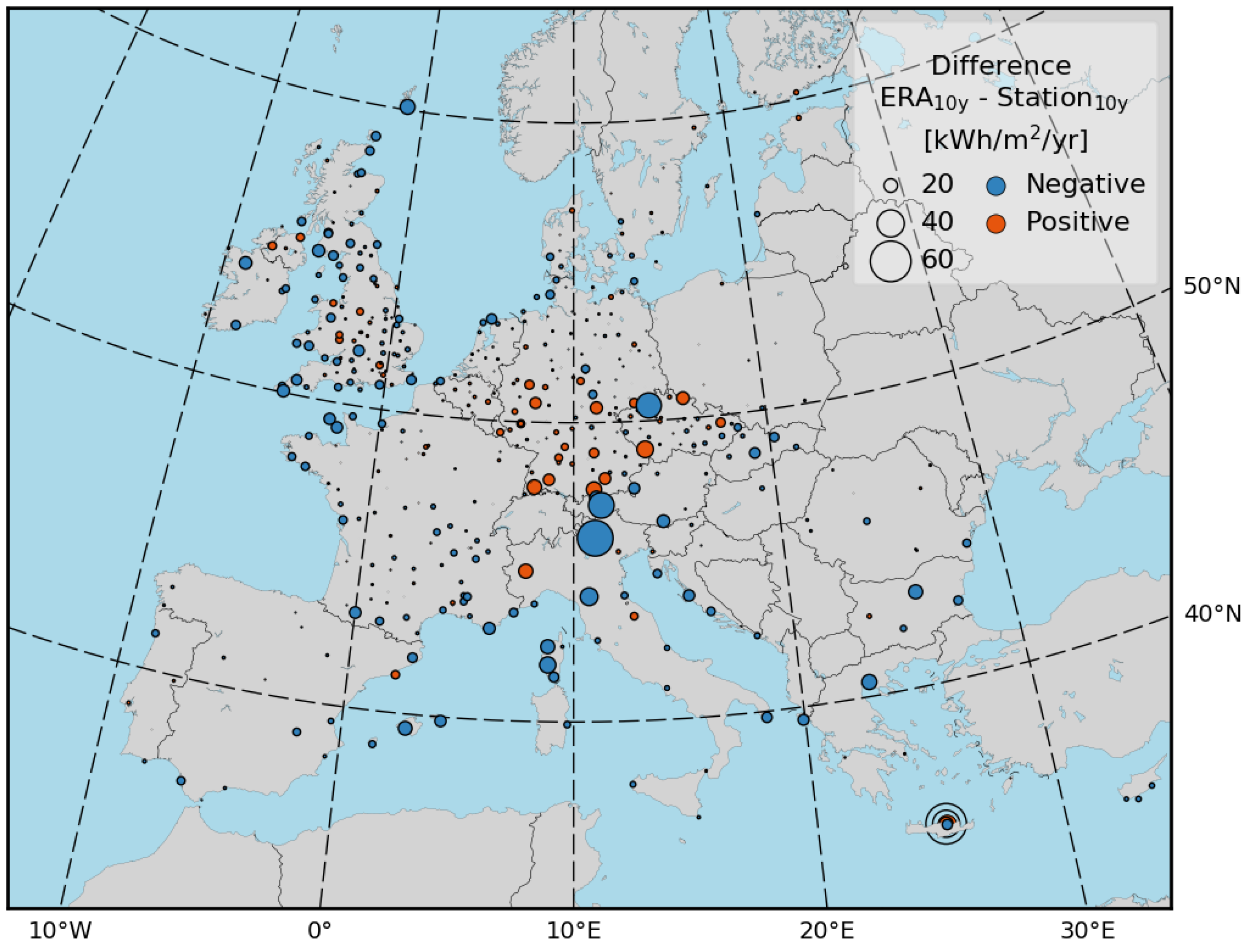
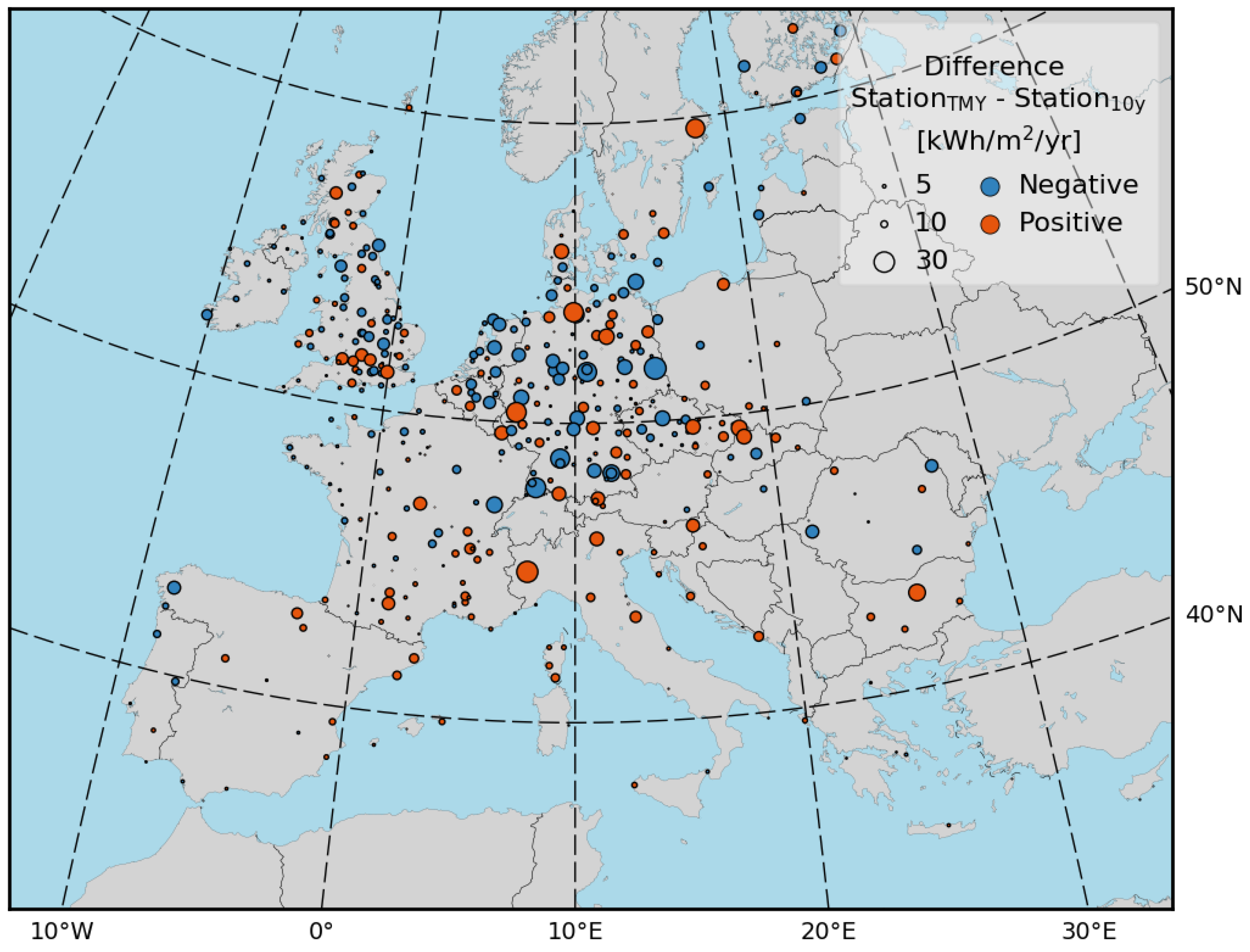
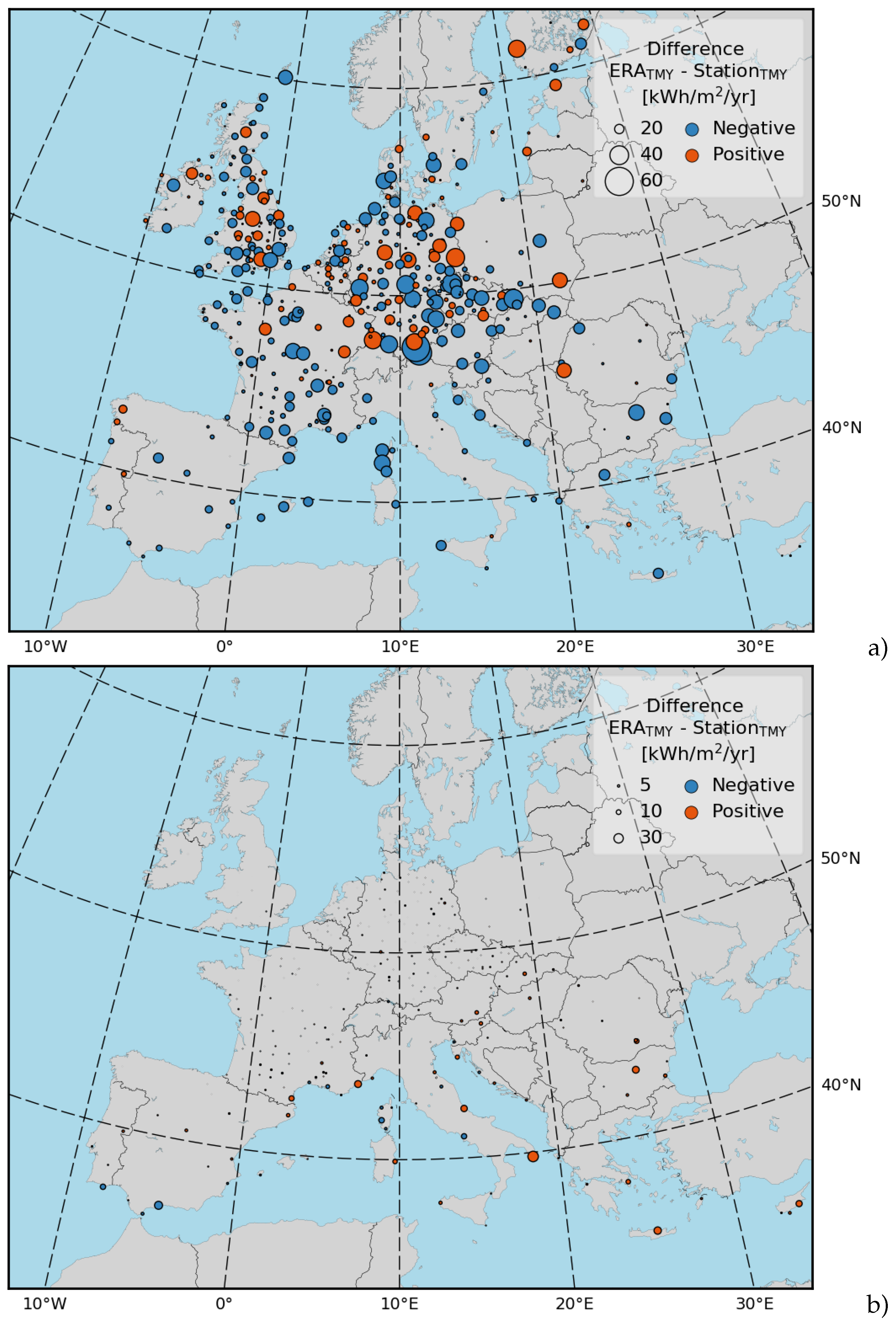
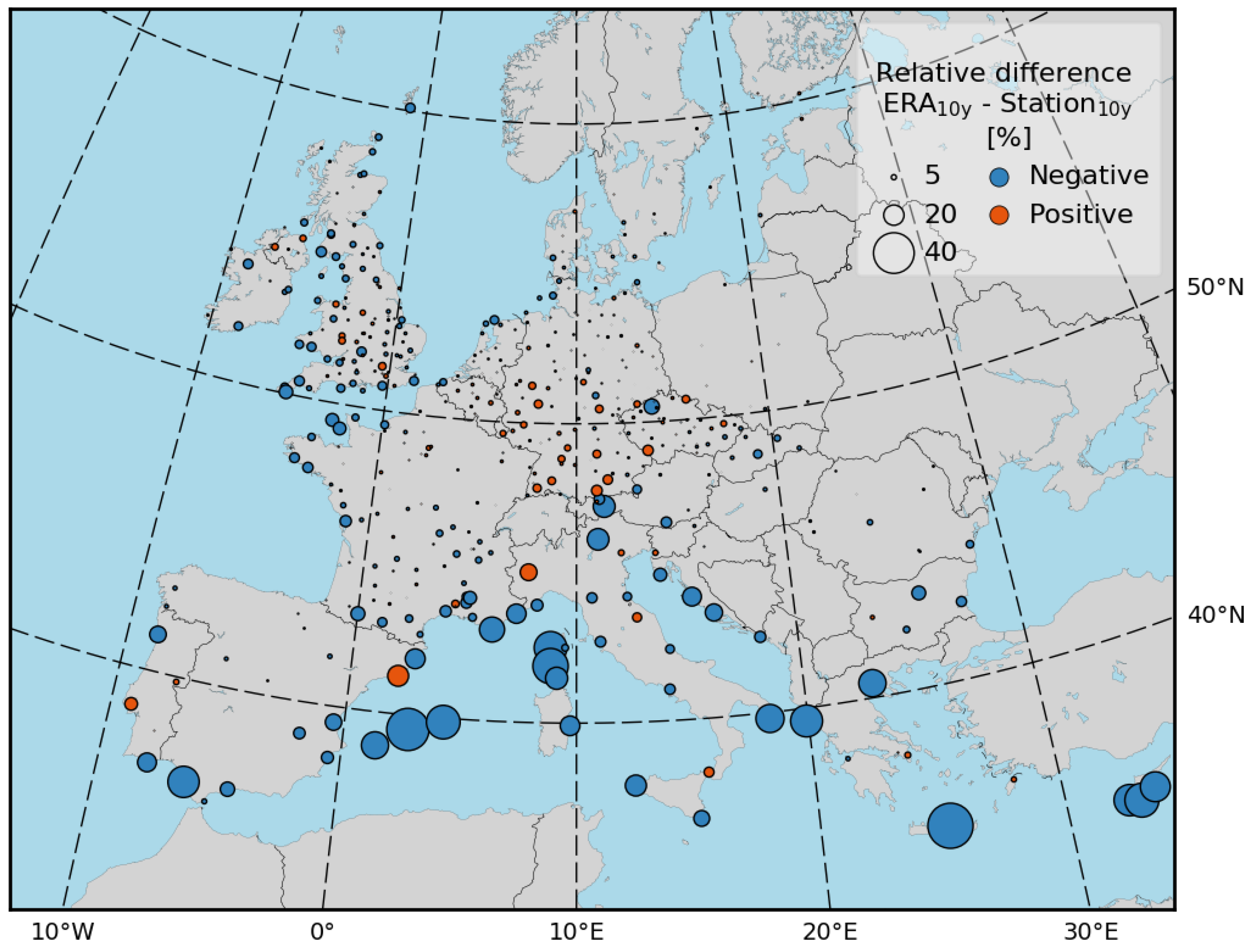
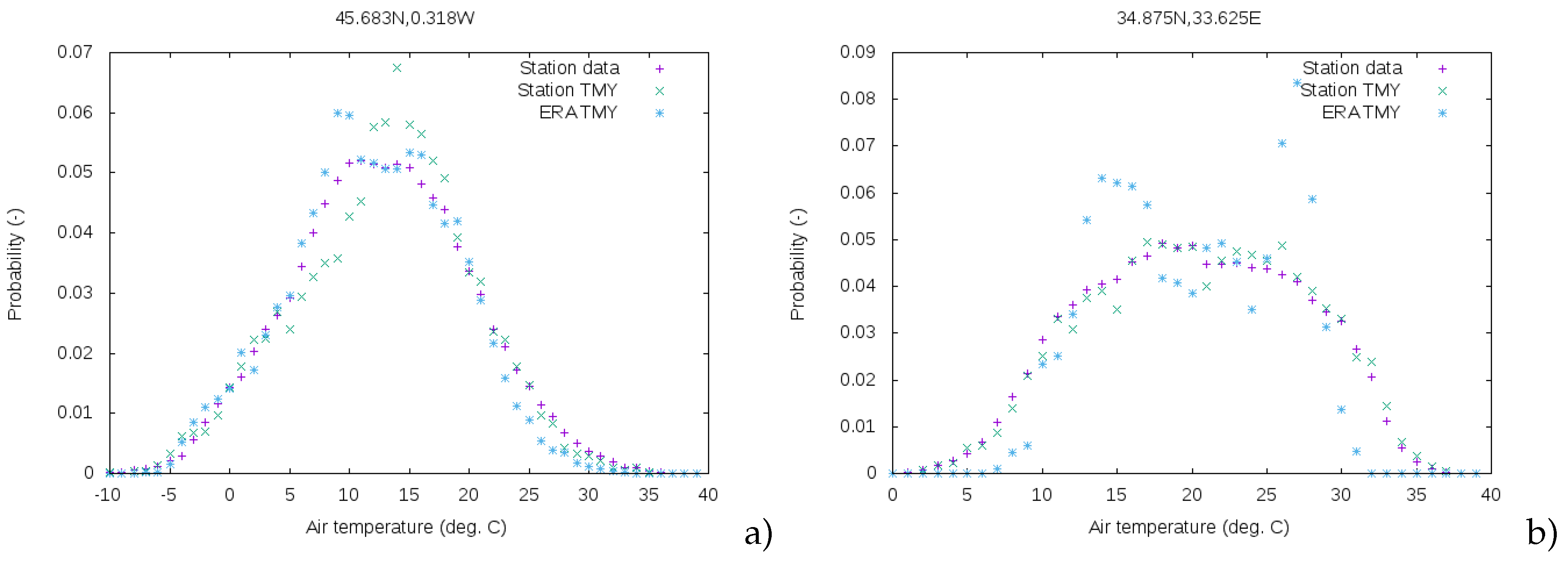
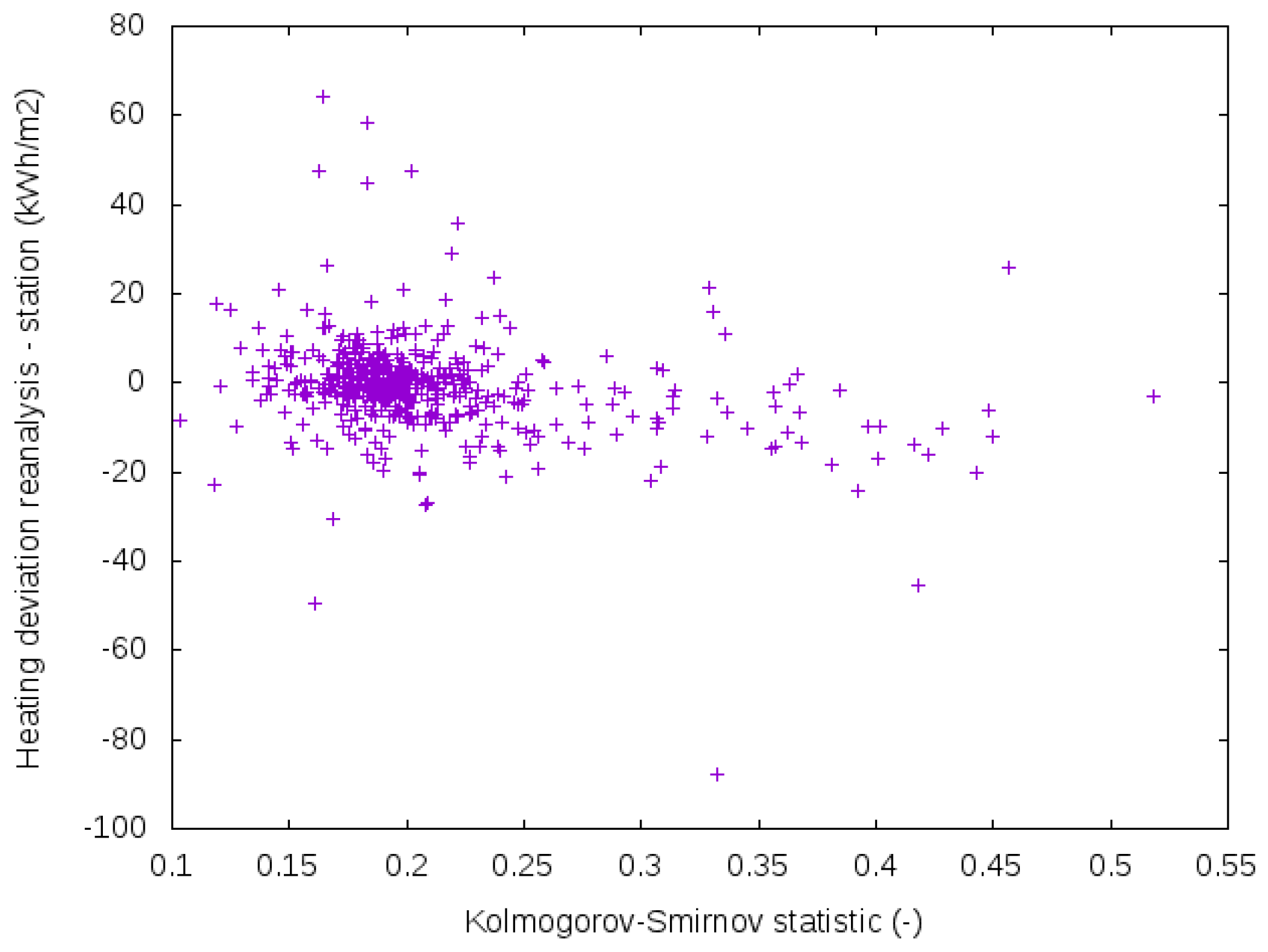
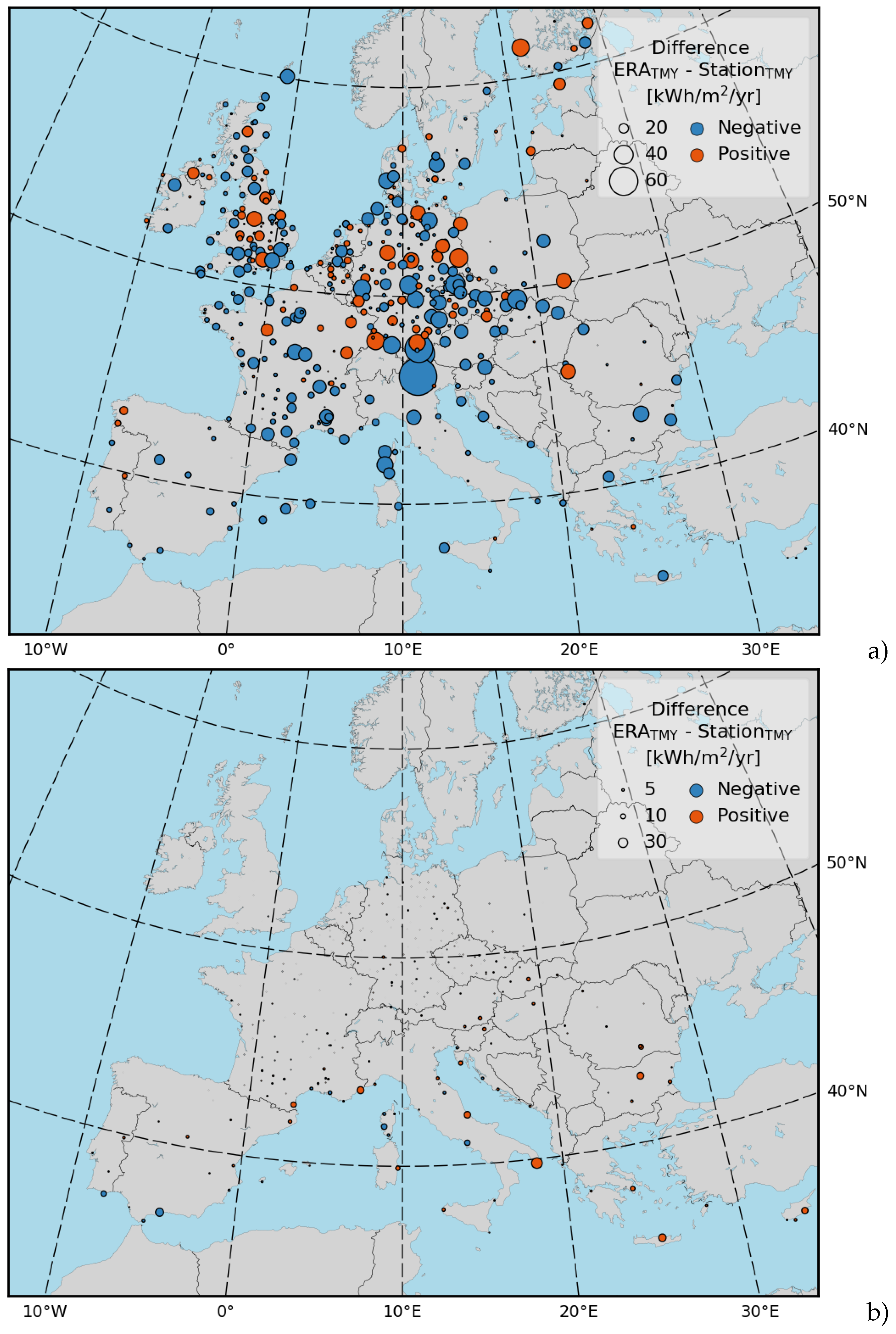
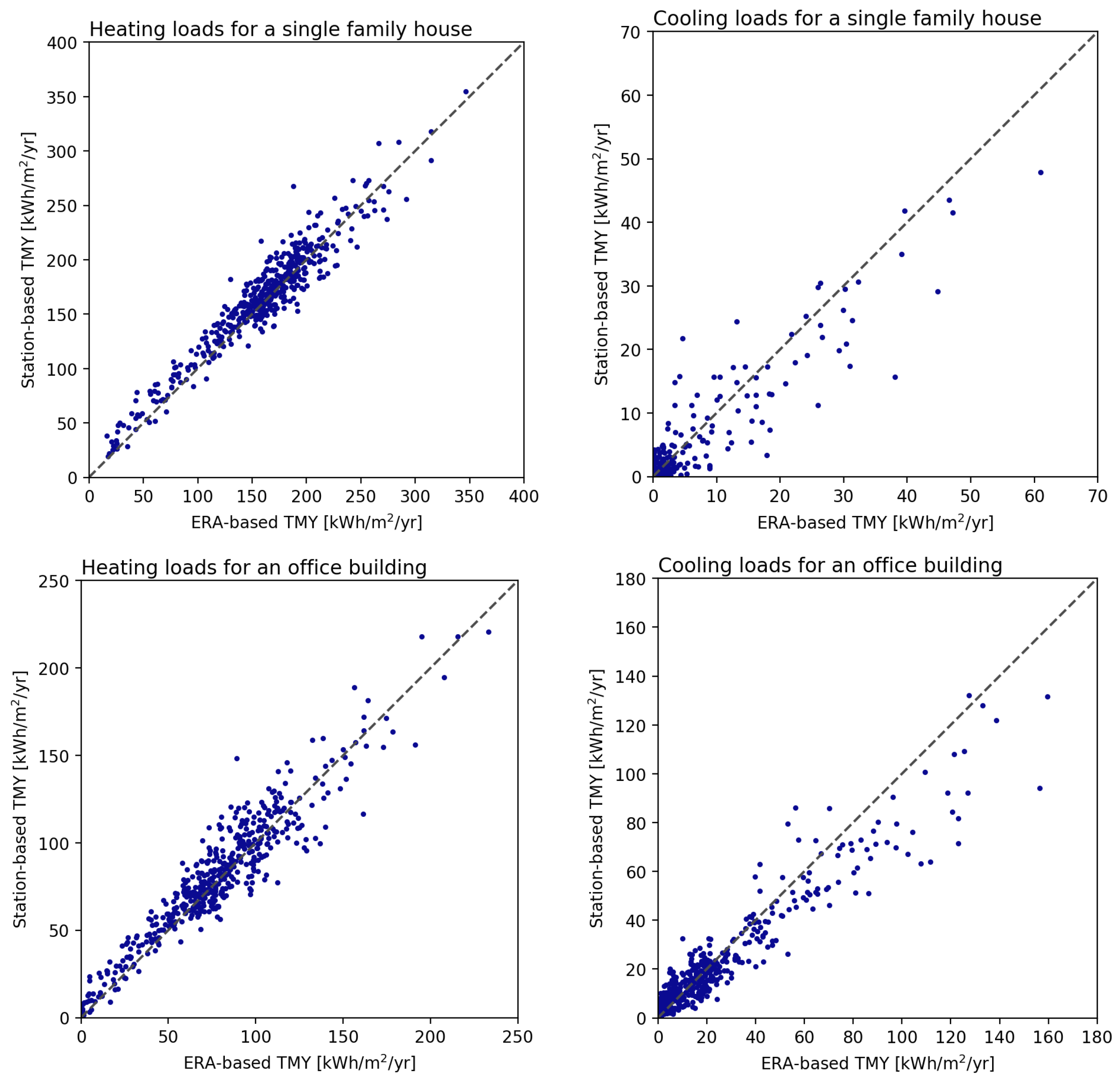
| Building Geometry | ||
|---|---|---|
| Parameter | House | Office |
| No. of heated floors | 2 | 5 |
| Area/Volume ratio | 0.7 | 0.33 |
| Orientation: | S/N | S/N |
| Net dimensions of heated volume (m) | ||
| Net floor area of heated zones (m) | 140 | 2400 |
| Area of S/N façade (m) | 51 | 450 |
| Area of E/W façade (m) | 51 | 240 |
| Area of Roof/basement (m) | 72.25 | 480 |
| Window area on S façade | 25% | 56% |
| Window area on E façade | 7% | 32% |
| Window area on N façade | 25% | 50% |
| Window area on W façade | 7% | 35% |
| Internal Gains | ||
| People design level (m/person) | 50 | 18 |
| Lighting design level (W/m) | 3.5 | 14 |
| Appliances design level (W/m) | 4 | 9 |
| Heating | Cooling | |||
|---|---|---|---|---|
| Station Average | 2786 | 231 | ||
| Comparison | MAD | SD | MAD | SD |
| Station 10 years vs. ERA 10 years | 116.9 | 161.9 | 56.2 | 79.7 |
| Station 10 years vs. Station TMY | 132.2 | 169.0 | 41.0 | 49.3 |
| Station 10 years vs. ERA TMY | 173.8 | 221.8 | 66.7 | 89.2 |
| Station TMY vs. ERA TMY | 203.0 | 257.6 | 78.9 | 100.6 |
| Heating | Cooling | |||
|---|---|---|---|---|
| Station Average () | 163.6 | 12.2 | ||
| Comparison | MAD | SD | MAD | SD |
| Station 10 years vs. ERA 10 years | 6.0 | 8.4 | 3.5 | 5.1 |
| Station 10 years vs. Station TMY | 7.6 | 9.8 | 2.0 | 2.5 |
| Station 10 years vs. ERA TMY | 10.3 | 13.0 | 3.7 | 5.1 |
| Station TMY vs. ERA TMY | 12.7 | 16.2 | 4.4 | 6.0 |
| Heating | Cooling | |||
|---|---|---|---|---|
| Station Average () | 80.5 | 21.6 | ||
| Comparison | MAD | SD | MAD | SD |
| Station TMY vs. ERA TMY | 9.8 | 12.8 | 6.1 | 9.7 |
| Heating | Cooling | |||
|---|---|---|---|---|
| Comparison | MAD | SD | MAD | SD |
| Station vs. interpolated station | 0.2 | 0.5 | 0.2 | 0.2 |
| Station vs. nearest neighbour | 8.2 | 11.1 | 3.6 | 5.1 |
© 2018 by the authors. Licensee MDPI, Basel, Switzerland. This article is an open access article distributed under the terms and conditions of the Creative Commons Attribution (CC BY) license (http://creativecommons.org/licenses/by/4.0/).
Share and Cite
Huld, T.; Paietta, E.; Zangheri, P.; Pinedo Pascua, I. Assembling Typical Meteorological Year Data Sets for Building Energy Performance Using Reanalysis and Satellite-Based Data. Atmosphere 2018, 9, 53. https://doi.org/10.3390/atmos9020053
Huld T, Paietta E, Zangheri P, Pinedo Pascua I. Assembling Typical Meteorological Year Data Sets for Building Energy Performance Using Reanalysis and Satellite-Based Data. Atmosphere. 2018; 9(2):53. https://doi.org/10.3390/atmos9020053
Chicago/Turabian StyleHuld, Thomas, Elena Paietta, Paolo Zangheri, and Irene Pinedo Pascua. 2018. "Assembling Typical Meteorological Year Data Sets for Building Energy Performance Using Reanalysis and Satellite-Based Data" Atmosphere 9, no. 2: 53. https://doi.org/10.3390/atmos9020053




